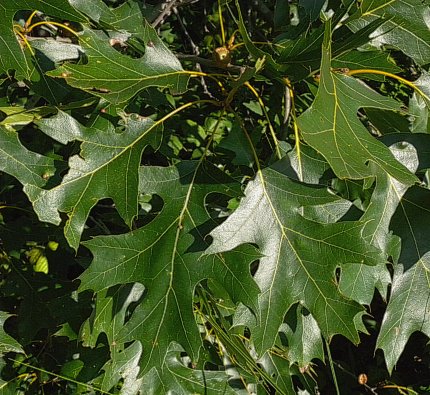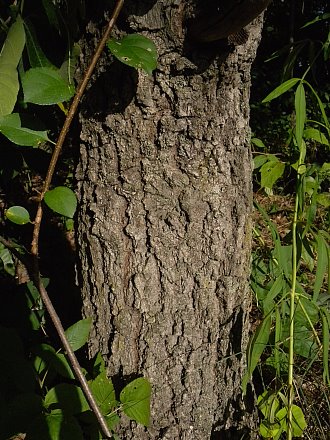
Black Oak is monoecious, producing male (staminate) and female (pistillate) flowers on the same tree. The inflorescence of male flowers consists of a cluster of drooping yellowish catkins about 4-6" long. The central stalks of the catkins are pubescent. The female inflorescence consists of a short spike of 1-4 reddish female flowers. Each female flower consists of an ovoid ovary with a conspicuous tripartite style; the ovary is surrounded by floral bracts (phyllaries) that are scaly and pubescent. The blooming period occurs from mid- to late spring. The flowers are wind-pollinated. The catkins of male flowers soon wither away, while fertile female flowers are replaced by acorns. These acorns require 2 years to fully develop; at maturity, they are ½-¾" long and ovoid-globoid in shape. Each acorn has a cup at its apex that extends downward to about 1/2 of its length; the relatively loose scales of the cup become smaller as they approach its lower rim. Along the lower rim of the cup, the scales form a short fringe. Each acorn contains a single large seed. The woody root system produces a deep taproot and lateral roots. This tree reproduces by reseeding itself. The deciduous leaves become dull red, yellow, or brown during the fall.

Cultivation: The preference is full or partial sun and mesic to dry conditions. Black Oak adapts to many types of soil, including those that contain deep loam, clay, rocky material, or sand. This tree begins the production of acorns after 20 years, and its longevity is not uncommonly 150-200 years. An infestation of oak wilt disease can be fatal.
Range & Habitat: The typical variety of the native Black Oak is a common tree that is found in every county of Illinois (see Distribution Map). The other variety of Black Oak (var. missouriensis), is restricted to a few southern counties within the state, where it is uncommon. This tree is native to the state. Habitats include upland woodlands, rocky open woodlands, sandy woodlands, upland savannas and sandy savannas, stabilized sand dunes, thinly wooded bluffs and rocky ridges, sandstone and limestone glades, and woodland borders. Sometimes Black Oak is the dominant canopy tree in sandy woodlands, sandy savannas, and upland rocky areas. It is rarely cultivated as a landscape tree.
Faunal Associations: Like other oaks (Quercus spp.), Black Oak is beneficial to many kinds of wildlife. The foliage, wood, plant juices, etc., are eaten by such insects as the larvae of metallic wood-boring beetles, the larvae of long-horned beetles, larvae of bark beetles, leaf beetles, weevils, larvae of gall flies, plant bugs, stink bugs, aphids, leafhoppers, treehoppers, armored scales, mealybugs, larvae of gall wasps, larvae of sawflies, larvae of Duskywing skippers (Erynnis spp.), larvae of Hairstreak butterflies (Satyrium spp.), and larvae many moths. These moths include tiger moths, ribbed cocoon-making moths, case-bearer moths, Geometer moths, leaf blotch miner moths, lappet moths, slug caterpillar moths, midget moths, owlet moths, prominent moths, giant silk moths, clear-winged moths, trumpet leaf-miner moths, and Tortrix moths (see Beetle Table, Aphid Table, Moth Table, and Miscellaneous Insect Table). These insects attract many kinds of insectivorous birds to oak trees, such as the Scarlet Tanager, Summer Tanager, Yellow-billed Cuckoo, Tufted Titmouse, Carolina Chickadee, Prothonotary Warbler, Northern Parula, Cerulean Warbler, Yellow-throated Warbler, Blue-gray Gnatcatcher, Acadian Flycatcher, Yellow-throated Vireo, and Red-eyed Vireo (Gabbe et al., 2002). Some birds also feed on the acorns of these trees, such as ducks, crows, bluejays, blackbirds, woodpeckers, nuthatches, upland gamebirds, and parakeets (see Bird Table). Many mammals also feed on the acorns. They include such species as the Gray Fox, White-tailed Deer, Prairie Vole, Meadow Vole, White-footed Mouse, Virginia Opossum, Raccoon, Southern Flying Squirrel, Eastern Gray Squirrel, Fox Squirrel, American Red Squirrel, Eastern Chipmunk, Muskrat (minor), and American Black Bear. In addition, Elk and White-tailed Deer browse on the twigs and foliage of oaks, while the Cottontail Rabbit gnaws on the bark of saplings and the American Beaver gnaws on the wood and bark when these trees occur near bodies of water (Martin et al., 1951/1961; Hamerstrom & Blake, 1939; Whitaker, 1966; Beeman & Pelton, 1980; Schneider et al., 2006). Tree squirrels and bluejays, in particular, spread acorns to new locations.

Black Oak and other oak trees provide protective cover to many kinds of wildlife. Such birds as the Red-shouldered Hawk, Cerulean Warbler, Hooded Warbler (saplings), Blue-gray Gnatcatcher, Eastern Wood-pewee, Yellow-throated Vireo, and Field Sparrow (saplings) select these trees as locations for their nests (Dijak et al., 1990; Newell & Rodewald, 2011; Bielefeldt & Rosenfeld, 2001; Best, 1978). And several bat species select oak trees as daytime roost sites and locations for their maternity colonies. This includes the Silver-haired Bat (Lasionycteris noctivagans), Evening Bat (Nycticeius humeralis), Big Brown Bat (Eptesicus fuscus), Hoary Bat (Lasiurus cinerens), Little Brown Bat (Myotis lucifugus), Tricolored Bat (Perimyotis subflavus), Indiana Bat (Myotis sodalis), and Long-eared Northern Bat (Myotis septentrionalis); see Perry et al. (2010), Perry & Thill (2008), Swier (2003), Veilleux et al. (2003), Baerwald et al. (2012), and Carter (2003).
Photographic Location: A sandy area near Lake Michigan at Indiana Dunes State Park in NW Indiana.

Comments: Black Oak is a member of the "red oak group" that has leaves with pointed bristly lobes and acorns that require 2 years to mature. The shape of its leaves are more variable than most oaks. At one time, the yellow-orange inner bark was used heavily in the leather tanning industry and it also produced an important yellow dye. Like other oaks, the heavy wood of Black Oak is hard and strong, therefore it is used to make wooden furniture, floors, interior finishing, barrels, railroad ties, and other wooden products. Black Oak can be distinguished from other oaks by the patches of tan or reddish brown hair that occur near the forks of the veins on the lower sides of its leaves (for the typical variety), the relatively long and slightly fringed cups of its acorns, and its often yellowish petioles. A southern variety of Black Oak (var. missouriensis), is slightly different by having a scurfy pubescence on the lower side of its leaves.